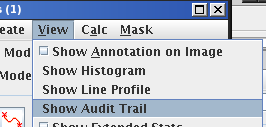View menu of the
ROI Toolkit:  .
.
Jim has been designed with clinical trials in mind, where it is necessary to provide a history of information - called the audit trail - that can be used by auditors to reconstruct the way in which statistics were derived.
Whenever ROIs are created, modified, or deleted, the history of these actions is written to disk when the ROIs are saved. The audit trail information is contained in a list of "History" items (one list for each ROI), built up according to the following rules:
You can view the ROI audit trail information from the View menu of the
ROI Toolkit:  .
.
When you have an ROI selected, the audit trail viewer will then show in the audit trail information tabulated for that ROI:

Show Deleted ROIs
checkbox in the ROI Toolkit View menu.
The form a history list is
given in Backus-Naur Form (BNF) notation below.
<history-list> ::= |
<history-spec>|<history-list><history-spec> |
|---|---|
<history-spec> ::= |
<action-spec><date-time-spec><user-spec> |
<action-spec> ::= |
Created | Modified | Deleted |
date-time-spec ::= |
"dd mmm yyyy hh:mm:ss.SSS zzzz" |
user-spec ::= |
by Operator ID="operator-id-spec" |
operator-id-spec ::= |
<string-spec> |
<string-spec> is a string of
ASCII text characters enclosed in double quotation marks (").
The operator-id-spec String is normally obtained from the logged-in user ID of the operator. If the computer system being used does not require a formal login procedure, then the operator will be prompted by Jim for a String identifier.
An example history item is:
Created "16 Dec 2005 12:24:41.678 GMT+00:00" by Operator
ID="xinapse". The time is shown to the nearest
millisecond, and the time zone is also shown.
Thus, a History item can record the creation, modification or deletion of an ROI, the date and time of the action, and the logged-in operator ID of the person who performed the action.
The full format of the ROI specification is given in the file formats section.